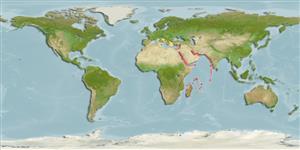Environment: milieu / climate zone / depth range / distribution range
ນິເວດວິທະຍາ
ສັດທະເລ ອາໄສຢູ່ໃກ້ໜ້າດິນໃຕ້ພື້ນທ້ອງນ້ຳ; ລະດັບຄວາມເລິກ 20 - 52 m (Ref. 123119). Subtropical
Western Indian Ocean: Red Sea to Oman, Madagascar, South Africa, Eastern Mediterranean (via Suez Canal).
Length at first maturity / ຂະໜາດ / ນ້ຳໜັກ / Age
Maturity: Lm 10.6, range 10 - 10.9 cm
Max length : 19.0 cm TL ຕົວຜູ້/ບໍ່ມີເພດ; (Ref. 11441); ນ້ຳໜັກສູງສຸດທີ່ເຄຍຈັດພີມມາ: 70.00 g (Ref. 124816)
ຄີ (ໜາມ)ແຂງຢູ່ຫຼັງປາ (ທັງໝົດ): 7; ຄີຫຼັງຂອງປາ (ຄີອ່ອນ) (ທັງໝົດ): 9. This species is distinguished by the following characters: D VII,9; pectoral fins 13-15; gill rakers 7-8 + 18-21 = 25-29. Measurements as % SL: body depth at first dorsal fin origin 21-24, at anus 18-22; caudal-peduncle depth 8.8-10; maximum head depth 18-21; head depth through eye 14-16; head length 26-380; snout length 9.5-12; orbit length 5.8-7.8; upper jaw length 9.9-12; barbel length 16-19; caudal-fin length 27-29; anal-fin height 14-17; pelvic-fin length 19-23; pectoral-fin length 18-22; first dorsal-fin height 18-22 with dorsal spines proportionally decreasing in height; second dorsal-fin height 13-17. Caudal fin of adults with 11-16 total bars, upper caudal-fin lobe with 5-6 reddish or red-brown bars, with 4-5 (rarely 3) bars distally from fork, and 1 bar close to lobe base, mostly narrower than the pale interspaces between bars; the ventral half side of lower lobe with 5-9 red, red-brown or grey bars, extending to a broad red, brown or dark-grey stripe along middle of lobe; inner, dorsal third of
lower caudal-fin lobe with 3-4 red, red-brown or grey bars; when preserved the caudal-fin bar pigmentation often retained; fresh fish sometimes with a faint
or (in life) conspicuous red or red-brown mid-lateral stripe from snout through eye to caudal-fin base, not retained in preservative. Colouration: barbels are white or creamy white in fresh fish; head and body colour white, pale grey or pale yellow ventrally and red brown or grey dorsally; the belly is white; when preserved the is body pale brown ventrally and often dorsally darkened (Ref. 123119).
Occurs in shallow littoral zone to 52 m depth (Ref. 123119); shallow dpeth from Khalaf et al., 1997 (Ref. 48643). Feeds on hypobenthic invertebrates, mainly crustaceans and, to a lesser extent, polychaetes, which they detect with their barbels (Ref. 43448).
Randall, J.E., 1995. Coastal fishes of Oman. University of Hawaii Press, Honolulu, Hawaii. 439 p. (Ref. 11441)
IUCN Red List Status (Ref. 130435)
Threat to humans
Harmless
Human uses
ຂໍ້ມູນຕື່ມອີກ
ເອກະສານອ້າງອີງການລ້ຽງສັດນ້ຳຂໍ້ມູນການລ້ຽງສັດນ້ຳສາຍພັນກຳມະພັນElectrophoresesການຖ່າຍທອດທາງກຳມະພັນຈາກພໍ່ແມ່ຫາລູກພະຍາດການປຸງແຕ່ງNutrientsMass conversion
ຜູ້ຮ່ວມມືຮູບStamps, Coins Misc.ສຽງຫອຍມີພິດຊະນິດນຶ່ງທີ່ອາໄສໃນທະເລຄວາມໄວປະເພດການລອຍເນື້ອທີ່ເຫືອກOtolithsສະໝອງວິໄສທັດ
ເຄື່ອງມື
Special reports
Download XML
ແຫຼ່ງອີນເຕີເນັດ
Estimates based on models
Preferred temperature (Ref.
123201): 19.3 - 27.6, mean 25.6 °C (based on 548 cells).
Phylogenetic diversity index (Ref.
82804): PD
50 = 0.5000 [Uniqueness, from 0.5 = low to 2.0 = high].
Bayesian length-weight: a=0.00832 (0.00687 - 0.01007), b=3.09 (3.06 - 3.12), in cm total length, based on LWR estimates for this species (Ref.
93245).
ຊັ້ນເຂດຮ້ອນ (Ref.
69278): 3.5 ±0.5 se; based on diet studies.
ຄວາມຢືດຢຸ່ນ (Ref.
120179): ຂະໜາດກາງ, ປະຊາກອນຕຳ່ສຸດທີ່ໃຊ້ເວລາສອງເທົ່າ 1.4 - 4.4 ປີ (Preliminary K or Fecundity.).
Fishing Vulnerability (Ref.
59153): Low vulnerability (10 of 100).
Nutrients (Ref.
124155): Calcium = 118 [62, 269] mg/100g; Iron = 0.989 [0.472, 1.838] mg/100g; Protein = 17.7 [15.7, 20.0] %; Omega3 = 0.408 [0.250, 0.733] g/100g; Selenium = 17.9 [9.4, 36.6] μg/100g; VitaminA = 27.5 [8.4, 106.9] μg/100g; Zinc = 0.96 [0.57, 1.39] mg/100g (wet weight);
